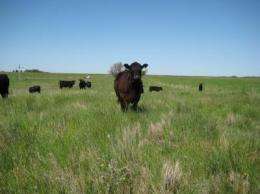How grazing lands influence greenhouse gas

Grazinglands represent one of the largest land resources in the world, yet their role as net sinks or sources of greenhouse gases is essentially unknown. Previous research has emphasized the role of grazing management on the sequestration of atmospheric carbon dioxide as soil organic carbon. However, there is a lack of information regarding how grazing management impacts the flux of two potent GHGs, nitrous oxide and methane.
A team of scientists lead by Mark Liebig at the USDA-ARS Northern Great Plains Research Laboratory estimated net global warming potential for three grazing management systems located in central North Dakota. The grazing management systems represented two native vegetation pastures under medium and high grazing pasture management, and a heavily grazed seeded crested wheatgrass pasture receiving supplemental nitrogen. The results indicate that grazinglands are strong sinks of soil organic carbon and minor sinks of methane, but small to moderate sources of nitrous oxide. Results from the study were published in the May-June 2010 issue of Journal of Environmental Quality, published by the America Society of Agronomy, the Crop Science Society of America, and the Soil Science Society of America.
Net global warming potential for the native grasslands was negative, implying an overall removal of greenhouse gases from the atmosphere. This finding underscores the value of grazed, mixed-grass prairie as a viable agroecosystem to serve as a net greenhouse gas sink in the northern Great Plains. Conversely, the seeded forage nitrous oxide emissions were nearly three times that of the native grasses, which contributed a net positive net global warming potential, implying net greenhouse gas emission to the atmosphere.
The research team was able to estimate global warming potential for each management practice by measuring changes in soil organic carbon, and nitrous oxide and methane flux. This data was combined with estimates for methane emissions from cattle and carbon dioxide emissions associated with applying nitrogen fertilizer.
"It's important to keep in mind the greenhouse gas balance we measured for the grazing treatments falls short of encompassing the full life-cycle of a steer," said Mark Liebig. "While our results suggest grazed native vegetation in the northern Great Plains is a net GHG sink, we need to acknowledge there is additional greenhouse gas emissions associated with cattle production outside of what we measured or estimated."
More information: View the abstract at www.agronomy.org/files/publica … 09-0272-abstract.pdf
Provided by American Society of Agronomy


















